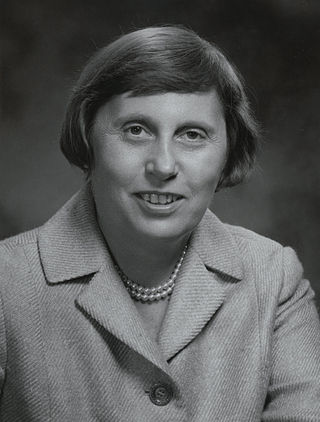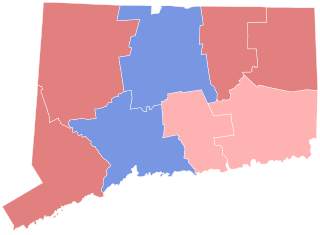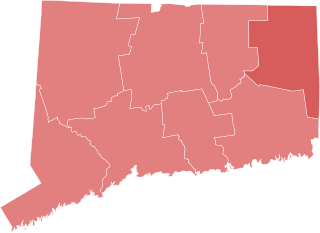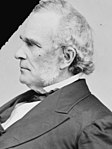
Ella Rosa Giovianna Oliva Grasso was an American politician and member of the Democratic Party who served as the 83rd governor of Connecticut from January 8, 1975, to December 31, 1980, after rejecting past offers of candidacies for Senate and governor. She was the first woman elected governor in Connecticut and the fourth woman to be elected governor of a U.S. state. She is also the first female governor to not be the spouse or widow of a former governor. She resigned as governor due to her battle with ovarian cancer.

There have been 91 gubernatorial elections in the state of New York since 1777, with the most recent being held on November 8, 2022. The next election is scheduled to be held on November 3, 2026.

The 1944 United States Senate elections coincided with the re-election of Franklin D. Roosevelt to his fourth term as president. The 32 seats of Class 3 were contested in regular elections, and three special elections were held to fill vacancies.

Horatio Seymour was an American politician. He served as Governor of New York from 1853 to 1854 and from 1863 to 1864. He was the Democratic Party nominee for president in the 1868 United States presidential election, losing to Republican Ulysses S. Grant.

The 1962 California gubernatorial election was held on November 6, 1962. The Democratic incumbent, Pat Brown, ran for re-election against former U.S. vice president and 1960 Republican presidential nominee Richard Nixon. In his concession speech the following morning, Nixon accused the media of favoring his opponent Brown, stating that it was his "last press conference" and "You won't have Nixon to kick around any more." Six years later, Nixon was elected President of the United States, and exactly ten years after this press conference, he was re-elected in a landslide.

The 1910 New York state election was held on November 8, 1910, to elect the governor, the lieutenant governor, the Secretary of State, the state comptroller, the attorney general, the state treasurer, the state engineer and two judges of the New York Court of Appeals, as well as all members of the New York State Assembly and the New York State Senate. The voters were also asked if they approved a $2,500,000 bond issue for the improvement and extension of Palisades Interstate Park, which was answered in the affirmative, with 349,281 For and 285,910 Against. A constitutional amendment which proposed to add two judges to the New York Court of Appeals and to increase the judges' salaries was rejected by a margin of only 292 votes, with 332,300 For and 332,592 Against.

The 1862 New York state election was held on November 4, 1862, to elect the governor, the lieutenant governor, a Canal Commissioner, an Inspector of State Prisons and the Clerk of the Court of Appeals, as well as all members of the New York State Assembly.

The 1906 California gubernatorial election was held on November 6, 1906. James Gillet won the 1906 election and became the governor of California. This was the first election in which more votes were cast in Los Angeles County than in San Francisco, possibly as a result of the earthquake seven months earlier in San Francisco.

The 2010 Connecticut gubernatorial election took place on November 2, 2010, to elect the 88th Governor of Connecticut. Incumbent Republican Governor Jodi Rell had announced in a press conference in Hartford on November 9, 2009, that she would not seek re-election in 2010. The sites Cook Political Report and CQ Politics both rated the election as a toss-up. This was the first open seat gubernatorial election in the state since 1994. As of 2025, this is the last time the Governor's office in Connecticut changed partisan control.
Since the Great Depression, Rhode Island politics have been dominated by the Rhode Island Democratic Party, and the state is considered part of the Democrats' "Blue Wall." Democrats have won all but four presidential elections since 1928, with the exceptions being 1952, 1956, 1972, and 1984. The Rhode Island Republican Party, although virtually non-existent in the Rhode Island General Assembly, has remained competitive in gubernatorial elections, having won one as recently as 2006. Until 2014, Democrats had not won a gubernatorial election in the state since 1992, and it was not until 2018 that they won one by double digits. The Rhode Island General Assembly has continuously been under Democratic control since 1959.
War Democrats in American politics of the 1860s were members of the Democratic Party who supported the Union and rejected the policies of the Copperheads, or Peace Democrats. The War Democrats demanded a more aggressive policy toward the Confederacy and supported the policies of Republican President Abraham Lincoln when the American Civil War broke out a few months after his victory in the 1860 presidential election.

The 1876 Colorado gubernatorial election took place on October 3, 1876, to elect the 1st Governor of Colorado after the state was admitted to the union on August 1, 1876. Republican John Long Routt, last governor of the Colorado Territory, was elected in a close race against Democratic nominee Bela M. Hughes.

The 1867 Connecticut gubernatorial election was held on April 1, 1867. It was a rematch of the 1866 Connecticut gubernatorial election. Democratic nominee James E. English defeated incumbent governor, former Civil War general and Republican nominee Joseph Roswell Hawley with 50.52% of the vote.

The 1865 Connecticut gubernatorial election was held on April 3, 1865, the last such election held during the American Civil War, and the last gubernatorial election in which the Republicans adopted the National Union Party name. It was a rematch of the 1864 Connecticut gubernatorial election. Incumbent governor and National Union nominee William Alfred Buckingham defeated Democratic nominee Origen S. Seymour with 57.48% of the vote. It was the eighth and last of Buckingham's consecutive victories.

The 1864 Connecticut gubernatorial election was held on April 4, 1864, and the first of two gubernatorial elections in which the Republicans adopted the National Union Party name, as the national party had done during the 1864 presidential election. Incumbent governor and National Union nominee William Alfred Buckingham defeated Democratic nominee Origen S. Seymour with 53.65% of the vote.

The 1863 Connecticut gubernatorial election was held on April 6, 1863. It was a rematch of the 1860 Connecticut gubernatorial election. Incumbent governor and Republican nominee William Alfred Buckingham defeated former governor and Democratic nominee Thomas H. Seymour with 51.64% of the vote.

The 1861 Connecticut gubernatorial election was held on April 1, 1861. Incumbent governor and Republican nominee William Alfred Buckingham defeated Democratic nominee James Chaffee Loomis with 51.23% of the vote.

The 1860 Connecticut gubernatorial election was held on April 2, 1860. Incumbent governor and Republican nominee William Alfred Buckingham defeated former governor and Democratic nominee Thomas H. Seymour with 50.30% of the vote.

The 1859 Connecticut gubernatorial election was held on April 4, 1859. It was a rematch of the 1858 Connecticut gubernatorial election. Incumbent governor and Republican nominee William Alfred Buckingham defeated former congressman and Democratic nominee James T. Pratt with 51.19% of the vote.

The 1858 Connecticut gubernatorial election was held on April 5, 1858. Former Norwich mayor and Republican nominee William Alfred Buckingham defeated former congressman and Democratic nominee James T. Pratt with 51.97% of the vote.





















